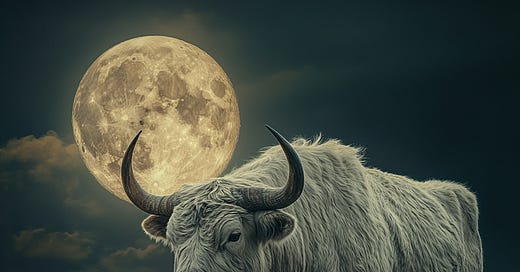Myth of the Day: Erchitu
In the enigmatic world of Sardinian folklore, the Erchitu emerges as an eerie omen, an alabaster beast of death, and potential liberation.
Region/Culture: Sardinia, Western Europe
Mythos: Sardinian Tradition
Primary Type/Nature: Undead/Cursed Beings
Mythical Attributes: Transforms into a white ox with large horns during full moons.
Role in Mythos: Acts as an omen of death, bellowing three times outside a home to signify the master’s impending demise within a year.
Relation to Humans: Its presence is considered an omen of death for the head of a household it visits. Additionally, only brave and strong humans capable of extinguishing the candles on its horns or cutting the horns off can free the Erchitu from its curse.
In the twilight expanses of Sardinian folklore, where superstition intertwines seamlessly with everyday life, the Erchitu holds a somber place of prominence. While some mythical beings flirt with the boundaries of good and evil, the Erchitu leaves no room for ambiguity—it is an omen of death, as stark and inescapable as a setting sun.
Imagine, if you will, an ox, but not just any ox. This creature is uncanny in its alabaster whiteness, its coat glowing as if moonlight itself had conspired to give it form. Its large, imposing horns curve menacingly, like scythes poised to harvest souls. What further distorts this already haunting image is the occasional sight of candles flickering on its horns, prodded into place by none other than shadowy devilish figures. In this ethereal form, the Erchitu makes its dreaded appearances on the nights of a full moon.
The Erchitu is not born but rather cursed into existence, a twisted rebirth of a malevolent spirit or an individual who led a wicked life. The transformation from human or spirit to Erchitu seems less an evolution and more a sentence—a grim destiny to serve as a herald of mortality. The creature is constrained to wander, its purpose irrevocably bound to its fate as an omen. When the Erchitu appears, it bellows three times outside a home, sealing the doom of the household’s patriarch, who is destined to meet an unfortunate end within a year. This is not a myth designed to entertain; it is one to remind, caution, and, in some paradoxical way, prepare the living for the inevitability of death.
This creature isn’t entirely devoid of complexities. Despite its daunting aura and grim purpose, the Erchitu isn’t completely invincible nor entirely devoid of a desire for liberation. Here lies the contradiction—it is an agent of fate, and yet its own fate can be altered. Brave and strong humans can free the Erchitu from its terrible curse. To do so, one has to either extinguish the candles on its horns or cut the horns off altogether. It’s as if this beast’s ferocity is counterbalanced by its hidden yearning to be unshackled from its doleful existence.
To encounter the Erchitu is to confront a visceral embodiment of the Sardinian ethos—a complex mixture of awe, reverence, and fear towards the inexorable march of time and life’s transient nature. But it also offers a sliver of hope, the potential for liberation not just for itself but also for those brave enough to face it. Yet, like any formidable mythical creature, challenging it is a perilous endeavor, filled with mortal risks and cosmic uncertainties.
Suggested Further Reading
If you enjoy our content, please consider making a donation to support the people of Ukraine. Click here to visit the official Ukrainian donation website.
Explore more myths and wonders by visiting godsandmonsters.info.
Enjoy mythic tales on the move with our podcast, Five Minute Mythology.





There are no candles on the creature's horns though